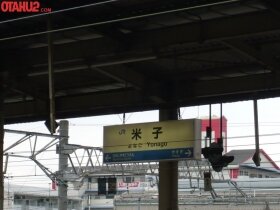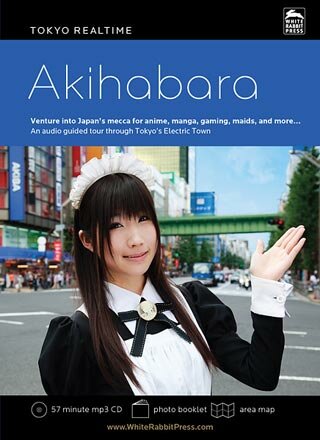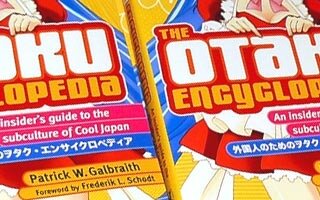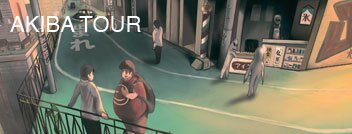 Filed under: Mizuki Shigeru Manga Travel
Filed under: Mizuki Shigeru Manga TravelMizuki Shigeru Memorial Museum
11.09.2009 by Patrick W. Galbraith
As retarded as it may sound, at one point I went on a sojourn across Japan in search of places associated with otaku. The far end of this included a stop in Tottori Prefecture, from where many of the founders of Gainax hail. The local dialect is to say "you" as "otaku," and some say the origin of the word as we know it today was fans of Gainax copying their vernacular. While in the area, I took a trip out to Sakaiminato, the birthplace of manga pioneer Mizuki Shigeru.
Mizuki is perhaps Japan's most respected author of horror manga an expert on Japanese yokai, or Japanese ghouls. Those who are interested might want to check out Matt Alt's "Yokai Attack!" a great guide illustrated by Morino Tatsuya, a former assistant to Mizuki. His more famous works include "GeGeGe no Kitaro," "Akuma-kun" and "Kappa no Sanpei." What is cool about these works is that Mizuki is fascinated with the otherworldly and grotesque and treats his subjects with respect and humor. When he was a child in Sakaiminato, an old lady, who he calls Non-non-ba, taught him all about yokai. He was drafted in 1942 at the age of 21, and served on New Britain Island in Papua New Guinea, where he lost his left arm. He miraculously returned to Japanese soil, and started drawing manga - despite being left-handed - and has continued for 40 years. In addition to yokai, Mizuki's experiences in WWII comprise his other major concern as a creator.
I first arrived at Yonago to transfer to a small local line for Sakaiminato, which is way up on the coast of the Sea of Japan. From here on out I was surrounded by yokai. The directions for the transfer and the station itself were decorated with characters from "GeGeGe no Kitaro." The train to Mizuki's hometown was a moving shrine to his work; both the inside and outside of the quaint little locomotive where painted with one of four themes: Kitaro, Medama-oyaji, Neko Musume or Nezumi Otoko. Each station on the line was named after a different yokai or character from Mizuki's works, and had signs posted explaining the creatures. This in combination with the exquisite scenery of the area made time pass quickly.
Stepping off the train at Kitaro Station (a.k.a. Sakaiminato) was like stepping into another world. There are images or yokai everywhere, and maybe 100 bronze statues to boot, too many to see or photograph in one day. Locals call this thoroughfare the “Yokai Road.” It really is overwhelming to see how the town has transformed itself in honor of its most famous son (and draw in tourists and money during the continuing recession and shrinking number of children in rural areas). The police box is dominated by Kitaro; taxis have Medama-oyaji lights on their roofs; almost every store is selling yokai souvenirs, bread, beer, food and so on; there is even a shrine dedicated to yokai.
It is easy to get exhausted just walking down this road and taking in the sites, but this is only the warm up. At the end of a shopping street, just past a small yokai theme park is the Mizuki Shigeru Memorial Museum. It was opened March 8, 2003, to commemorate Mizuki's 81st birthday. His constant companions Kitaro and Nezumi Otoko are in the courtyard to welcome visitors from near and far. The museum begins with an extremely detailed exhibition on Mizuki's personal and professional history, including examples of his original work and explanations of their impact. Sadly, you can't expect English explanations. In brief, the man basically invented the horror manga genre in the 1960s, when the medium was becoming more sophisticated and targeting an adult audience.
Further on is a hall with large dioramas of yokai in their natural habit, for example where one might meet a towel ghoul or midget washing sweet beans. Add sound effects and spooky ambience and this is easily the highlight of the trip. However, there is plenty more to see, including manga representations of Mizuki's life and war experience. There are some very cool nuggets in here, for example the fact that Mizuki is still friendly with the Tolai tribes people on Rabaul, where he was a prisoner of war. Apparently they offered him land, citizenship and a wife after WWII, but lucky for manga fans he instead returned to Japan. He visited the area again in 2003, and they named a road after him. Another highlight of the visit is an area with displays of the old toys inspired by Mizuki's works, and a library containing all of his works. They are free to read for visitors.
The verdict: While a great visit, not everyone will want to make a special trip. It will take you at least a day of hard travel to get to Sakaiminato from Tokyo, so you have to stay overnight in Yonago, spend the next day in Sakaiminato and then spend the night someone before making the day-long journey home. In other words, it has to be a three-day weekend, and I am not sure a trip all the way to Tottori is the best way to spend it. It certainly is not the cheapest! Worth a stop if you are in the area.
 SAKAIGEGE
SAKAIGEGE




























































































Comment on this article

04.04.2010 · Blog
The reach of moe is long...
OK, so anime of late tends to put in cute girls to attract viewers and sell merchandise. Some people criticize and dismiss it for this...
22.03.2010 · Blog
Nippombashi Street Festa 2010
I shot over to Osaka for the Nippombashi Street Festa 2010. It was the sixth annual event, and by all accounts was a little more organized...
07.02.2010 · Features
Temple University Japan offers program in popular culture
Roland Kelts teaching anime, Patrick W. Galbraith manga
15.01.2010 · Blog
Tsutaya is renting manga
This really is going to be a happy new year! Tsutaya, Japan's largest chain of rental video stores, is now carrying manga. Lots of it. They...
28.09.2009 · Blog
Nippombashi pictures
Just some pics of the guys from Macross World and local Japanese otaku that showed me around Nippombashi last week. Thanks again Howard,...
11.08.2009 · Reviews
Mospeada Complete Art Works Book Review
The Mospeada Complete Art Works book just hit bookstores in Japan this past Saturday August 8th. It’s the eighth volume in the...
30.06.2009 · Blog
Kashihonya still exist!
And here I thought these were all gone! This one is in Kunitachi way out on the Chuo Line. Still in business, even with all the online...


























